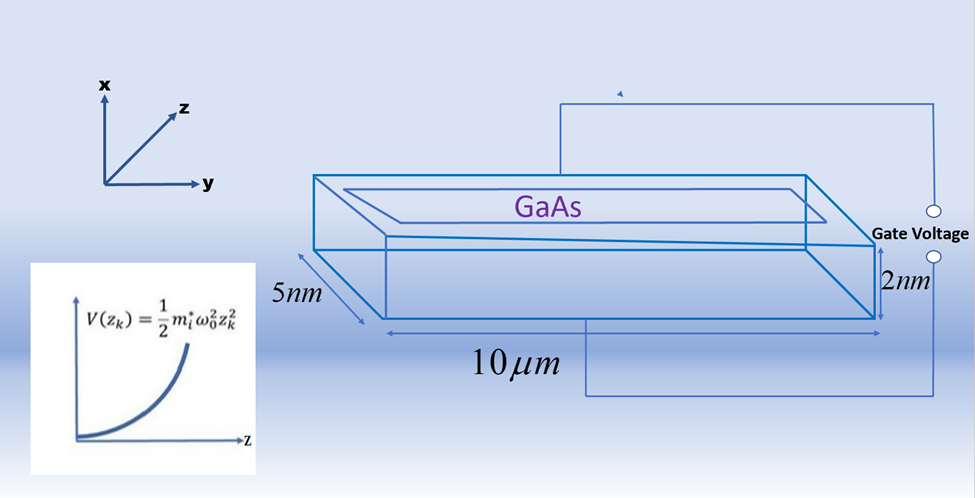Nanosystems: Phys. Chem. Math., 2024, 15 (5), 632–642
Tuning the nonlinear optical properties of a 1D excitonic GaAs quantum dot system under a semi-parabolic potential with a detailed comparison with the experimental results: interplay of hydrostatic pressure and temperature
Suman Dahiya – Department of Applied Physics, Delhi Technological University, Delhi 110042, India
Siddhartha Lahon – Physics Department, KMC, University of Delhi, Delhi 110007, India; sid.lahon@gmail.com
Rinku Sharma – Department of Applied Physics, Delhi Technological University, Delhi 110042, India; rinkusharma@dtu.ac.in
Corresponding author: Siddhartha Lahon, sid.lahon@gmail.com
DOI 10.17586/2220-8054-2024-15-5-632-642
ABSTRACT The present study is dedicated to study the effect of Temperature and Hydrostatic Pressure on the absorption coefficient and refractive index of one-dimensional semi-parabolic excitonic GaAs QD’s by applying the compact density matrix formalism. Calculations are performed to obtain the excitonic state wave functions and energies in the strong confinement regime using the effective mass approximation. A significant dependence of nonlinear optical refractive index and absorption coefficient on hydrostatic pressure and temperature can be observed for excitonic and without excitonic case. Our investigations show that the peaks blue/red shifts are substantial when the excitonic interactions are taken into account. The opposite effects caused by temperature and pressure have substantial practical importance as they extend an alternative approach to tune and control the optical frequencies resulting from the transitions. The comparative analysis of the analytical optical properties of excitonic system facilitates the experimental identification of these transitions which are often close. We have attempted a comparison of the absorption coefficient obtained in the present work with experimental data at T ∼= 10 and 100 K and found that the theoretical prediction is in agreement for T≅10 K and it is in slight deviation from the experimental data for higher temperatures. The whole of these conclusions may have broad implications in future designing of Optoelectronic devices.
KEYWORDS nanostructures, quantum dot, exciton, nonlinear effects, hydrostatic pressure, temperature
ACKNOWLEDGEMENTS We acknowledge sincere gratitude to Delhi Technological University to appreciate their help and enhance our services and facilities.
FOR CITATION Dahiya S., Lahon S., Sharma R. Tuning the nonlinear optical properties of a 1D excitonic GaAs quantum dot system under a semi-parabolic potential with a detailed comparison with the experimental results: interplay of hydrostatic pressure and temperature. Nanosystems: Phys. Chem. Math., 2024, 15 (5), 632–642.
[In Russian] Суман Дахия, Сиддхартха Лахон, Ринку Шарма
Настройка нелинейных оптических свойств 1-мерной экситонной системы квантовых точек GaAs c полупараболическим потенциалом с подробным сравнением с экспериментальными результатами: влияние гидростатического давления и температуры
АННОТАЦИЯ Настоящее исследование посвящено изучению влияния температуры и гидростатического давления на коэффициент поглощения и показатель преломления одномерных полупараболических экситонных квантовых точек GaAs с применением формализма компактной матрицы плотности. Расчеты проводятся для получения волновых функций и энергий экситонных состояний в режиме сильного ограничения с использованием приближения эффективной массы. Значительная зависимость нелинейного оптического показателя преломления и коэффициента поглощения от гидростатического давления и температуры может наблюдаться для экситонного и безэкситонного случая. Наши исследования показывают, что синие/красные сдвиги пиков существенны, когда учитываются экситонные взаимодействия. Противоположные эффекты, вызванные температурой и давлением, имеют существенное практическое значение, поскольку они расширяют альтернативный подход к настройке и управлению оптическими частотами, возникающими в результате переходов. Сравнительный анализ аналитических оптических свойств экситонной системы облегчает экспериментальную идентификацию этих переходов, которые часто близки. Мы попытались сравнить коэффициент поглощения, полученный в настоящей работе, с экспериментальными данными при T ≅ 10 К и 100 К и обнаружили, что теоретическое предсказание согласуется для T ≅ 10 К и немного отклоняется от экспериментальных данных для более высоких температур. Все эти выводы могут иметь широкие последствия для будущего проектирования оптоэлектронных устройств.
КЛЮЧЕВЫЕ СЛОВА Наноструктуры, Квантовая точка, Экситон, нелинейные эффекты, Гидростатическое давление, Температура
